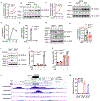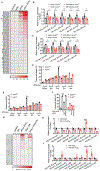CD8+ T cells and fatty acids orchestrate tumor ferroptosis and immunity via ACSL4
- PMID: 35216678
- PMCID: PMC9007863
- DOI: 10.1016/j.ccell.2022.02.003
CD8+ T cells and fatty acids orchestrate tumor ferroptosis and immunity via ACSL4
Abstract
Tumor cell intrinsic ferroptosis-initiating mechanisms are unknown. Here, we discover that T cell-derived interferon (IFN)γ in combination with arachidonic acid (AA) induces immunogenic tumor ferroptosis, serving as a mode of action for CD8+ T cell (CTL)-mediated tumor killing. Mechanistically, IFNγ stimulates ACSL4 and alters tumor cell lipid pattern, thereby increasing incorporations of AA into C16 and C18 acyl chain-containing phospholipids. Palmitoleic acid and oleic acid, two common C16 and C18 fatty acids in blood, promote ACSL4-dependent tumor ferroptosis induced by IFNγ plus AA. Moreover, tumor ACSL4 deficiency accelerates tumor progression. Low-dose AA enhances tumor ferroptosis and elevates spontaneous and immune checkpoint blockade (ICB)-induced anti-tumor immunity. Clinically, tumor ACSL4 correlates with T cell signatures and improved survival in ICB-treated cancer patients. Thus, IFNγ signaling paired with selective fatty acids is a natural tumor ferroptosis-promoting mechanism and a mode of action of CTLs. Targeting the ACSL4 pathway is a potential anti-cancer approach.
Keywords: ACSL4; PD-L1; T cell; arachidonic acid; cancer; ferroptosis; immunotherapy; interferon; oleic acid; palmitoleic acid.
Copyright © 2022 Elsevier Inc. All rights reserved.
Conflict of interest statement
Declaration of interests The authors declare no competing interests.
Figures






Comment in
-
CD8+ T cells PUF(A)ing the flames of cancer ferroptotic cell death.Cancer Cell. 2022 Apr 11;40(4):346-348. doi: 10.1016/j.ccell.2022.03.003. Epub 2022 Mar 24. Cancer Cell. 2022. PMID: 35334204
-
ACSL4, PUFA, and ferroptosis: new arsenal in anti-tumor immunity.Signal Transduct Target Ther. 2022 Apr 22;7(1):128. doi: 10.1038/s41392-022-01004-z. Signal Transduct Target Ther. 2022. PMID: 35459217 Free PMC article. No abstract available.
-
Pro-ferroptotic fatty acid metabolism renders cancer cells immunogenic.Trends Cancer. 2022 Oct;8(10):785-787. doi: 10.1016/j.trecan.2022.04.002. Epub 2022 Apr 22. Trends Cancer. 2022. PMID: 35469799
References
-
- Conrad M, and Pratt DA (2019). The chemical basis of ferroptosis. Nat Chem Biol 15, 1137–1147. - PubMed
Publication types
MeSH terms
Substances
Grants and funding
- R01 CA148828/CA/NCI NIH HHS/United States
- P30 CA046592/CA/NCI NIH HHS/United States
- R01 CA245546/CA/NCI NIH HHS/United States
- R01 CA217510/CA/NCI NIH HHS/United States
- R01 CA152470/CA/NCI NIH HHS/United States
- R01 CA123088/CA/NCI NIH HHS/United States
- R01 CA099985/CA/NCI NIH HHS/United States
- R01 CA261985/CA/NCI NIH HHS/United States
- R01 DK095201/DK/NIDDK NIH HHS/United States
- R01 CA244827/CA/NCI NIH HHS/United States
- R01 CA193136/CA/NCI NIH HHS/United States
- R01 CA248430/CA/NCI NIH HHS/United States
- R01 CA211016/CA/NCI NIH HHS/United States
LinkOut - more resources
Full Text Sources
Medical
Research Materials

